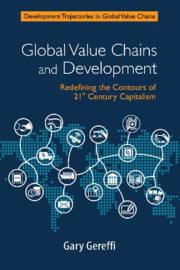Book contents
- Frontmatter
- Dedication
- Contents
- List of Tables
- List of Figures and Boxes
- Foreword
- Acknowledgments
- Sources
- 1 The Emergence of Global Value Chains: Ideas, Institutions, and Research Communities
- Part I Foundations of the Global Value Chain Framework
- Part II Expanding the Governance and Upgrading Dimensions in Global Value Chains
- Part III Policy Issues and Challenges
- 11 Global Value Chain Analysis: A Primer (Second Edition)
- 12 Global Value Chains, Development, and Emerging Economies
- 13 Risks and Opportunities of Participation in Global Value Chains
- 14 Global Value Chains in a Post-Washington Consensus World
- 15 Protectionism and Global Value Chains
- Co-authors
- Index
14 - Global Value Chains in a Post-Washington Consensus World
from Part III - Policy Issues and Challenges
Published online by Cambridge University Press: 09 November 2018
- Frontmatter
- Dedication
- Contents
- List of Tables
- List of Figures and Boxes
- Foreword
- Acknowledgments
- Sources
- 1 The Emergence of Global Value Chains: Ideas, Institutions, and Research Communities
- Part I Foundations of the Global Value Chain Framework
- Part II Expanding the Governance and Upgrading Dimensions in Global Value Chains
- Part III Policy Issues and Challenges
- 11 Global Value Chain Analysis: A Primer (Second Edition)
- 12 Global Value Chains, Development, and Emerging Economies
- 13 Risks and Opportunities of Participation in Global Value Chains
- 14 Global Value Chains in a Post-Washington Consensus World
- 15 Protectionism and Global Value Chains
- Co-authors
- Index
Summary
Viewing the Global Economy Through a Value-Chain Lens
Globalization has given rise to a new era of international competition that is reshaping global production and trade and altering the organization of industries (Gereffi, 2011). Since the 1960s, international companies have been slicing up their supply chains in search of low-cost and capable suppliers offshore. The literature on ‘the new international division of labor’ traced the surge of manufactured exports from the Third World to the establishment of labor-intensive export platforms set up by multinational firms in low-wage areas (Fröbel et al., 1981). This was typified by the American production-sharing or ‘twin plant’ program with Mexico and the German export-processing zones for apparel assembly in Central and Eastern Europe. The pace of offshore production soon accelerated dramatically and took new organizational forms (Dicken, 2011). In the 1970s and 1980s, US retailers and brand-name companies joined manufacturers in the search for offshore suppliers of most categories of consumer goods, which led to a fundamental shift from what had been ‘producer-driven’ commodity chains to ‘buyer-driven’ chains. The geography of these chains expanded from regional production-sharing arrangements to full-fledged global supply chains, with a growing emphasis on East Asia (Gereffi, 1994, 1996).
In the 1990s and 2000s, the industries and activities encompassed by global supply chains grew exponentially, covering not only finished goods, but also components and sub-assemblies, and affecting not just manufacturing industries, but also energy, food production, and all kinds of services, from call centers and accounting to medical procedures and research and development (R&D) activities of the world's leading transnational corporations (Engardio et al., 2003; Engardio and Einhorn, 2005; Wadhwa et al., 2008). Since the early 2000s, the global value chain (GVC) and global production network (GPN) concepts gained popularity as ways to analyze the international expansion and geographical fragmentation of contemporary supply chains (Gereffi et al., 2001; Dicken et al., 2001; Henderson et al., 2002; Gereffi, 2005).
There are numerous reviews of the distinctive features of the global commodity chain (GCC) and the GVC and GPN approaches to analyzing global supply chains. In general, they all characterize the global economy as consisting of complex and dynamic economic networks made up of inter-firm and intra-firm relationships. However, it is equally true that there are national and international political underpinnings to the shifts in global supply chains that have taken place over the past four decades.
- Type
- Chapter
- Information
- Global Value Chains and DevelopmentRedefining the Contours of 21st Century Capitalism, pp. 400 - 428Publisher: Cambridge University PressPrint publication year: 2018

